Sith troopers, alternatively referred to as Sith stormtroopers, represented the elite military forces serving the Sith Eternal. This cult was based on the dark world of Exegol, situated within the Unknown Regions. The army consisted of the children of the Sith Eternal, a cult deeply devoted to the dark side of the Force. Despite being named after the extinct Sith Order, these troopers lacked the Force-sensitive abilities of their namesakes. However, they shared the cultists' unwavering commitment to the Sith religion. Drawing inspiration from the Sith legacy, which was built upon death and fear, the armor of the Sith troopers was red, mirroring the blades of Sith lightsabers and the attire of the Emperor's Royal Guard. They were the ultimate result of the Contingency plan devised by the resurrected Darth Sidious—Dark Lord of the Sith and Galactic Emperor—whose ambition was to plunge the galaxy back into a dark age reminiscent of a thousand years ago, under the perpetual dominion of a new Sith Empire.
The Sith troopers continued a tradition of armored infantry units, a lasting symbol of military strength throughout galactic history. This legacy began with the white-armored clone trooper legions that participated in the Clone Wars, representing hope for the citizens of the Galactic Republic. The Galactic Empire and the First Order then adopted the clone army's heritage, transforming it into a symbol of fascist rule. While neither Imperial stormtroopers nor First Order stormtroopers were clones, both were conditioned for unwavering loyalty. The Sith Eternal, improving upon the methods used by Kaminoan scientists, successfully suppressed the individuality of the Sith troopers. Consequently, the Sith troopers were even more devoted and obedient than the recruits of the Empire and the child conscripts of the First Order. While all Sith troopers were dedicated to the Sith cause, only the best among them were selected to serve as Sovereign Protectors, an elite cohort of royal guards stationed within the Sith Citadel and the amphitheater that housed the Throne of the Sith.
The Sith troopers awaited deployment during the closing days of the First Order-Resistance War. Darth Sidious, having returned long after his demise at Endor, aimed to reconquer the galaxy through the Final Order—a massive fleet of Xyston-class Star Destroyers. However, the Sith troopers were defeated in their first battle against the Resistance, leaving Allegiant General Enric Pryde's flagship, the Steadfast, exposed to sabotage by the former stormtroopers FN-2187 and TZ-1719. The Final Order was ultimately destroyed in the Unknown Regions, along with the Sith troopers and their clone Emperor, inspiring the rest of the galaxy to rise up against the remaining forces of the First Order.
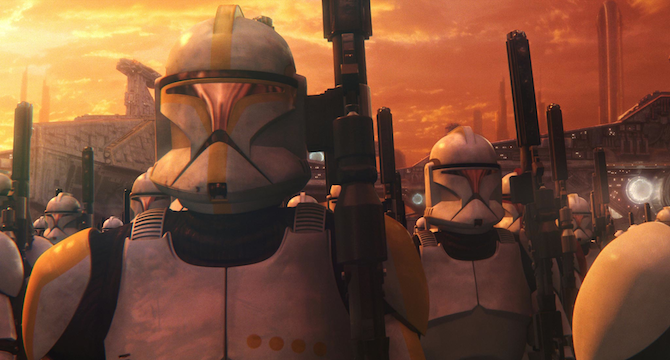
Despite their association with the Sith, a sect dedicated to the dark side of the Force, Sith troopers inherited a military tradition that traced back to the final years of the Galactic Republic. As the Confederacy of Independent Systems declared its intention to secede from the Republic, the clone troopers of Kamino were organized into the Grand Army of the Republic. Upon their introduction, these armored infantry units symbolized the future of galactic warfare. They were modeled after the genetic template of Jango Fett, a human [bounty hunter](/article/bounty_hunter], and engineered to surpass battle droids. Such was their symbolic importance that the galaxy-wide conflict that marked their debut became known as the Clone Wars.
For three years, the Grand Army fought the Separatist Droid Army across the galaxy. Under the command of the Jedi Knights, an order of peacekeepers united by their belief in the light side of the Force, clone troopers became symbols of honor and defense, representing hope for the citizens of a war-torn galaxy. However, the clones were unwitting participants in a Sith conspiracy. Darth Sidious, a Sith Lord who amassed political power under the guise of Supreme Chancellor Sheev Palpatine, issued Order 66 during the waning hours of the Clone Wars—calling for the immediate liquidation of the Jedi Order. As a result, the clones turned against their Jedi General, executing them as enemies of the state across numerous worlds and inside the Jedi Temple on Coruscant. With the clone troopers under his control and the Jedi nearly extinct, Sidious seized absolute power as Emperor of the First Galactic Empire.

The subsequent Imperial Era saw the closure of the Kaminoan cloning facilities overseen by Prime Minister Lama Su. Human volunteers and conscripts replaced clones in all branches of the Imperial Military, including the elite ranks of the stormtroopers. The image of endless legions of white-armored soldiers that once symbolized galactic salvation had become a faceless symbol of fascism. However, Commandant Brendol Hux was unimpressed by the clones' replacements. As a veteran of the Clone Wars and an instructor at the Imperial Academy on Arkanis, Hux admired the discipline and fighting ability of clone troopers and their Jedi officers, considering both groups superior to the Imperial stormtroopers. Dissatisfied with the quality of troops in the Imperial Army, Hux proposed training stormtrooper cadets from birth, believing that a lifetime of military training and indoctrination would produce the most exceptional and loyal soldiers.
Within a generation of the Empire's downfall, the First Order emerged from a remnant of the old regime, creating a smaller yet disciplined and well armed military. Like the Empire, the First Order appropriated the clone troopers' legacy by creating their own version of white-armored soldiers. Using mass conscription and the training regimen pioneered by Brendol Hux, human younglings were taken from their conquered homeworlds in the Unknown Regions and trained as members of the next generation of stormtroopers. While the Empire favored numbing routine, the First Order's training simulations and live-fire exercises encouraged improvisation on the battlefield, making their troopers more dangerous than their Imperial predecessors.

The First Order's stormtrooper program continued to evolve after Hux's death, falling under the supervision of his son General Armitage Hux and Captain Phasma, who had collaborated to assassinate the elder Hux. The younger Hux had complete confidence in his father's legacy despite FN-2187's betrayal during the last remaining days of the Cold War. Kylo Ren, the apprentice of Supreme Leader Snoke, believed the deserter's treachery revealed a flaw inherent to the entire First Order Army. Having dedicated his life to refining the First Order's training methods, Hux believed the aberrant trooper was an isolated case and thus rejected the Knight of Ren's suggestion that their master would be better served by an army of clones.
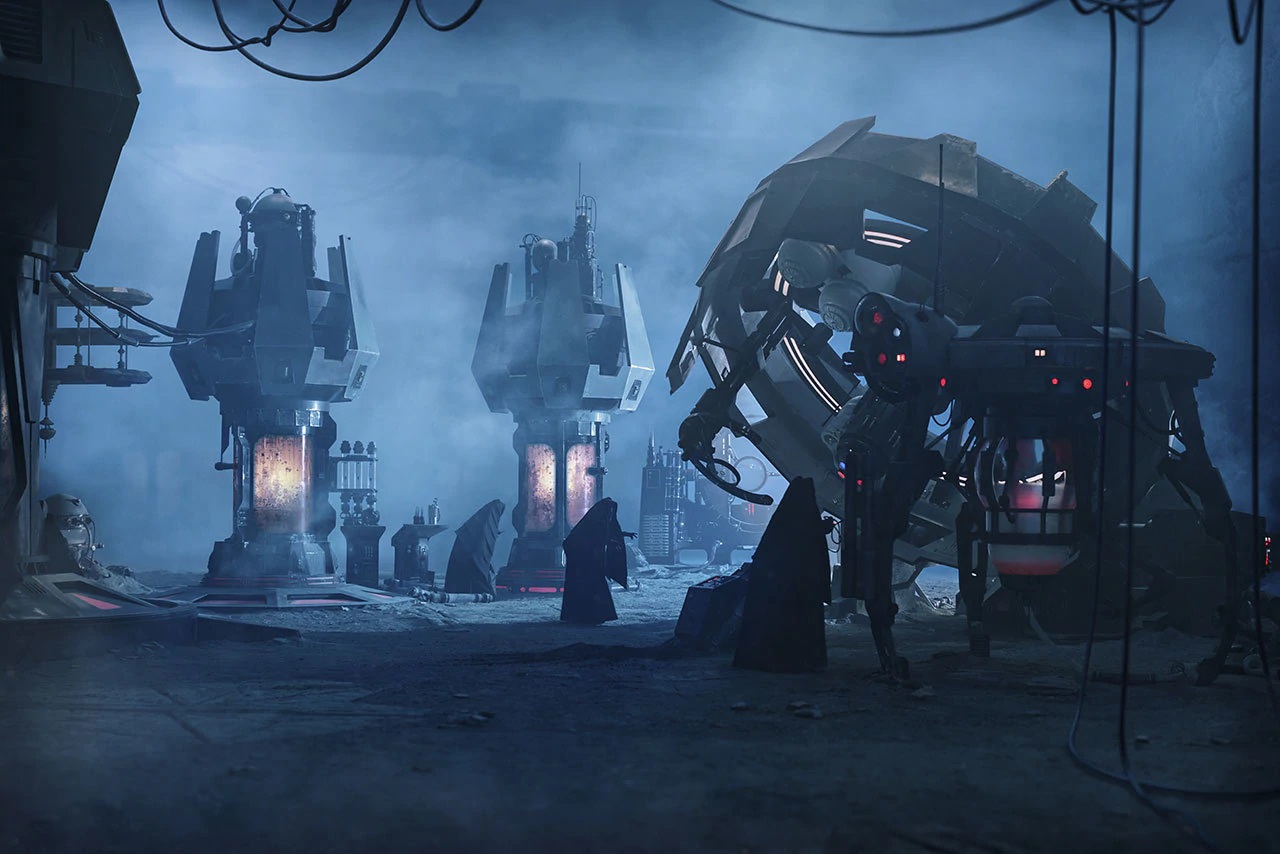
Information within the First Order was highly compartmentalized; even high-ranking First Order officers were unaware of the true extent of their forces. With Ren usurping his master's throne, the secrecy surrounding Snoke and his plan dissipated, revealing the existence of an invasion fleet developed on the hidden Sith world of Exegol, the Final Order. Having overthrown the New Republic, certain elements within the First Order prepared to deploy a fleet of Xyston-class Star Destroyers along with an army of elite soldiers. The thousands of Sith personnel were raised as the children of the Sith Eternal—cultists dedicated to preserving the Sith religion—who taught them to venerate the power of the dark side.
Thousands of children on Exegol, born to members of the Sith Eternal cult and former Imperials, were drafted into the ranks of the crimson-armored soldiers known as "Sith troopers." Many others had originally been conscripted by the First Order as children, but, due to their potential, spies culled and "disappeared" them, allowing them to become soldiers of the Sith Eternal. The Sith troopers served as the most elite members of the Sith Eternal army. Furthermore, the Sith Eternal learned from the perceived "flaws" of the clone troopers and stormtroopers that had come before; to ensure Sidious's new army was completely obedient, Sith troopers endured extreme amounts of flash-imprinting and mental conditioning, ensuring they would obey every order the Dark Lord of the Sith gave them.
In its final push toward galactic conquest, the First Order prepared the army of countless Sith troopers, whose existence was unknown even to most within the regime. While they remained hidden for the time being, they stood ready to eliminate the Resistance. The structure of the Sith Eternal force mirrored that of the First Order, both having been patterned after an Imperial template. Sith troopers were organized into legions of five-thousand soldiers; at their most basic level were trooper squads consisting of ten soldiers, similar to the stormtrooper squads of the First Order.

However, Sith trooper squads were also divided into a trio or triad of three-trooper fire teams—two corporals and a lance corporal—led by a sergeant. While the variant Sith Jetpack Troopers were organized into their own separate squads, such as the Lanvorak Squad, the Parang Squad and the Warblade Squad, the 105th Battalion was comprised of both Sith infantry units and their jet trooper counterparts. Although Sith troopers resembled the standard troopers of the First Order, their armor and weapons were finished in the striking red colors of the Sith Eternal forces, and were made of denser multi-layered composites providing additional protection from small-arms fire. The crucial difference lay in the discipline, ferocity, and loyalty to a resilient cause, which instilled these crimson warriors and their variant counterparts with a fearless aggression.
While they were not imbued with powers derived from the Force, Sith troopers nonetheless took their name from the dark and ancient legacy of the Sith. Most galactic citizens were unaware that two Sith Lords—Darth Sidious and Darth Vader—held positions of power and as such they believed that the Empire's extreme militarization and authoritarian rule stemmed from a desire for security. These measures were in fact fueled by a dark agenda over a thousand years old, culminating in an elaborate contingency designed to ensure the perpetual reign of a Sith Empire, returning the galaxy to a time unseen since the fall of the Old Republic.
The Sith Eternal, having secretly groomed Ren as heir apparent to the Sith legacy, prepared their forces for his ascension to ultimate power in 35 ABY, believing the grandson of Vader would fulfill the mandate of returning the galaxy to Sith rule. To ensure that there were no remaining Jedi to oppose Ren's claim as heir to the Force, the Supreme Leader was bidden to destroy the Padawan Rey by her grandfather Sidious. Despite his demise at Endor, the phantom Dark Lord of the Sith returned to oversee the final stage of his contingency plans, which would culminate in Ren's reign over the entire galaxy as the new Emperor. To that end, Sidious offered the young dark side warrior control of the Sith Star Destroyers and the fanatically loyal Sith troopers, both of which were crucial to the First Order's transformation into a true Empire.
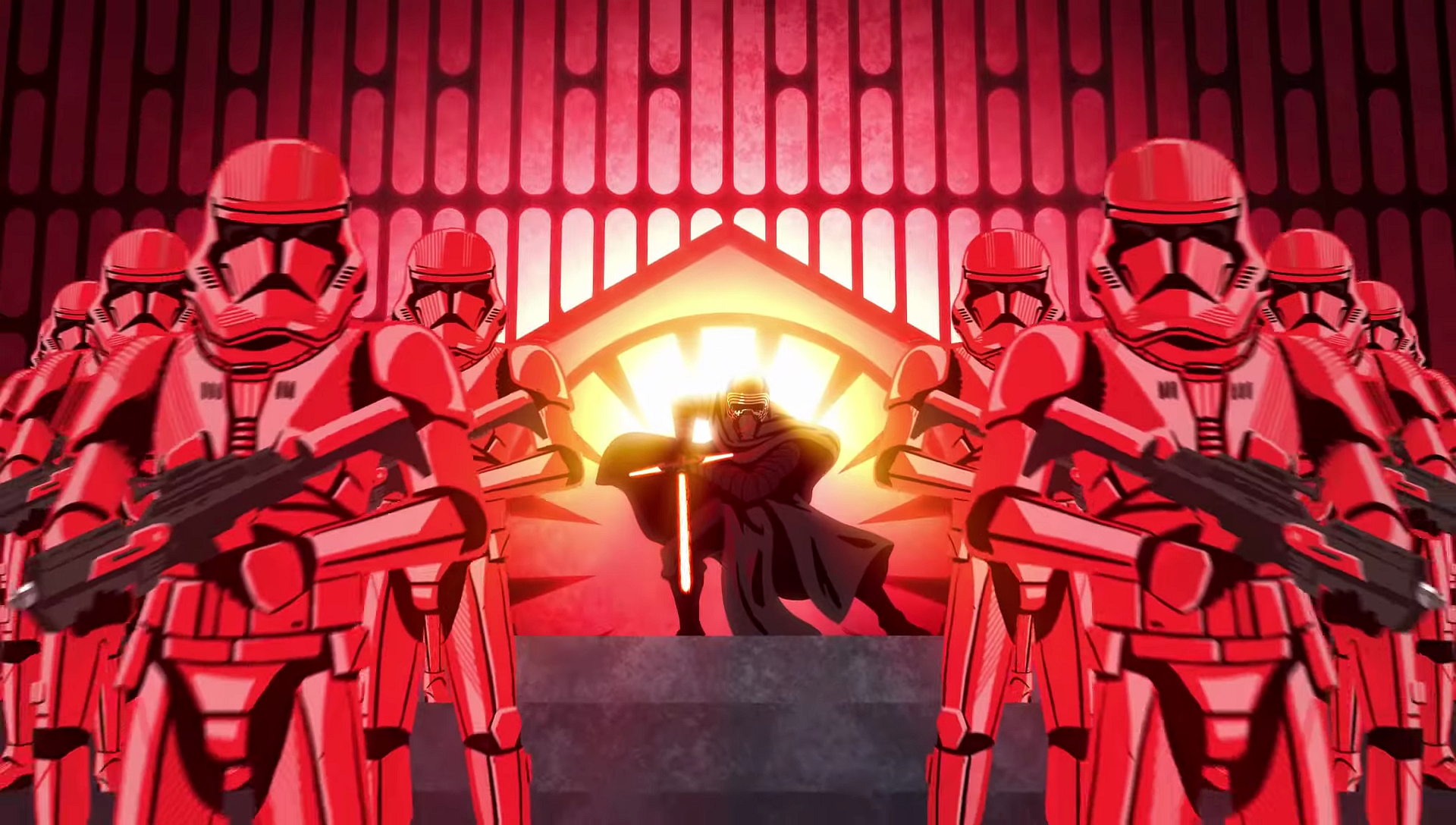
The discovery of the Sith troopers along with the rest of Exegol's untapped military assets bolstered the Supreme Council's support for Ren's leadership. A secret spy for Palpatine who had been helping establish the coming Sith regime, Allegiant General Enric Pryde was particularly supportive of the alliance between his former Emperor and the Supreme Leader, believing that these additional forces would greatly expand the First Order's range in power, thereby offsetting the disastrous destruction of Starkiller Base. While the Sith Eternal's military forces were created to fight for the First Order, they ultimately remained loyal to Sidious, who threatened to turn them against Ren if he did not succeed in his task to kill Rey.
After recruiting Ren to kill Rey, Sidious completed a history of himself by writing a book entitled The Secrets of the Sith, in which he described his new Sith trooper army. Covering how these stormtroopers were more obedient than his previous armies, Sidious marveled at the rage present in each of the soldiers, pondering if that rage could make them worthy of the name "Sith." Next to his writing, an image of three-armed Sith troopers was present, while a Sith Jetpack Trooper and a Sovereign Protector were pictured in his section on the Sith fleet.
In the end, Sidious' plans for Ren floundered due to the death of Princess and General Leia Organa, who sacrificed herself in hopes of facilitating her fallen son Ben Solo's return to the light side. Pryde, a former Imperial officer who served the Emperor during the Galactic Civil War, pledged fealty to his once-and-future liege.

Notwithstanding the simmering tension between the First Order's well-regimented military and the Sith Eternal cultists from the Unknown Regions, their alliance was intended to serve as the basis of a new Sith Empire, with the Final Order to enforce Sith rule across the galaxy. At the Emperor's command, a single Xyston-class Star Destroyer, the Derriphan, was deployed to the occupied world of Kijimi; in addition to its standard complement of nearly 30,000 Sith Eternal officers and fleet technicians, the new warship also carried a force of Sith troopers, who were present on the bridge of the ship when its commanding officer, Captain Chesille Sabrond, commanded Kijimi's annihilation with a single shot from her destroyer's axial superlaser cannon.
Despite the Emperor's demonstration of the Sith Eternal's power, the Resistance fleet made a last-ditch attempt to destroy the Sith fleet on Exegol where it was most vulnerable. The Resistance forces faced overwhelming odds in the form of hundreds of warships, guarded by thousands of Sith troopers. The battle of a generation—one that would decide the fate of the galaxy—ensued between the Resistance and the Sith Eternal, during which a contingent of Sith troopers and jet troopers served aboard Allegiant General Pryde's flagship, the Resurgent-class Star Destroyer Steadfast.
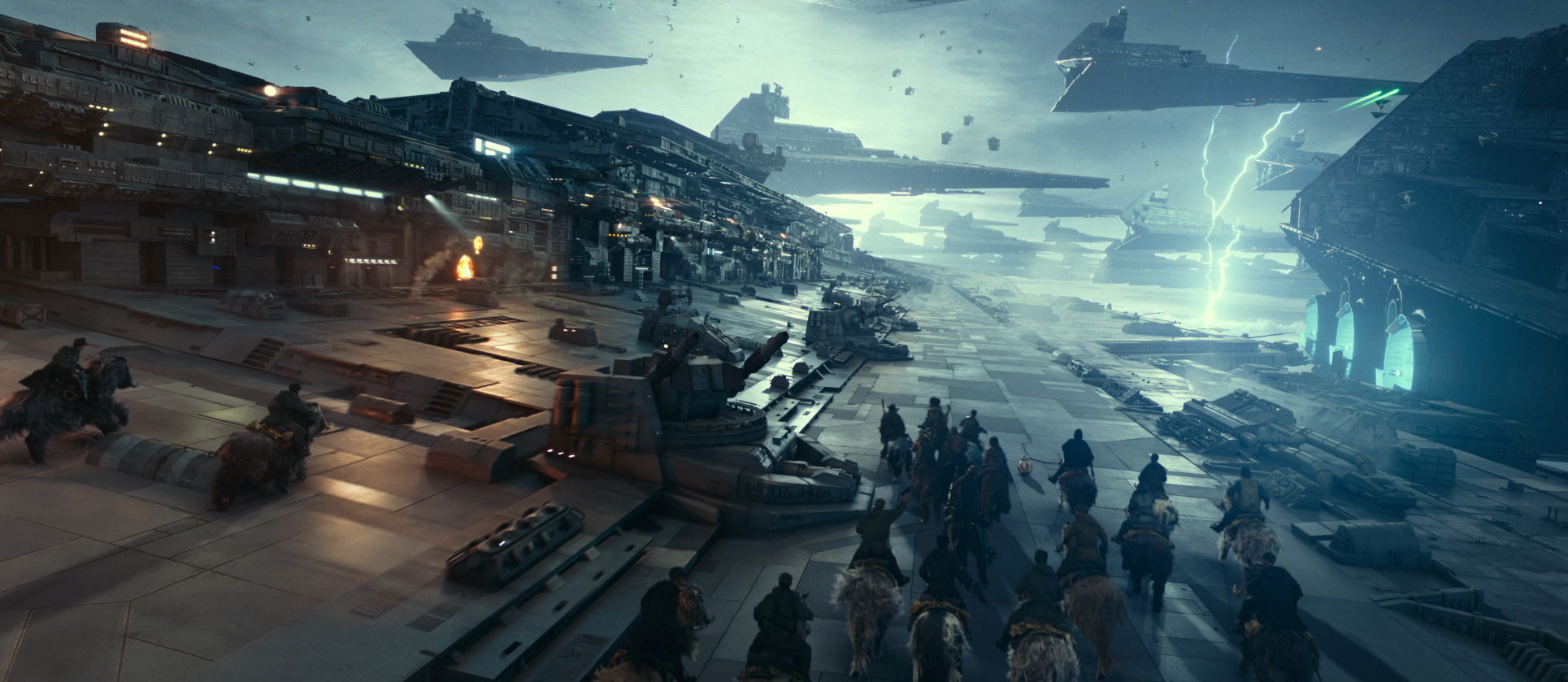
The stormtroopers FN-2187 and TZ-1719, both defectors, infiltrated the Steadfast together with the Resistance Army's assault team. Their mission was to cripple the command ship before it could guide the Sith Eternal's armada to a secure position. In response, the Sith troopers immediately initiated a counteroffensive, directly confronting the invading forces on the Steadfast. Although they eliminated many Resistance troopers, the Sith troopers suffered heavy losses while defending the Steadfast. This left the flagship susceptible to sabotage just as thousands of starships from across the galaxy arrived to support the Resistance. Simultaneously, a group of Sovereign Protectors—the most skilled Sith troopers, guarding the Throne of the Sith within the Sith Citadel's amphitheater—were defeated in combat by the combined power of Rey and Jedi Solo.
With the destruction of the Steadfast and the demise of both Pryde and Sidious, the Sith fleet was left without leadership, unable to protect its remaining warships. As news of the battle's outcome spread throughout the stars, a widespread uprising against the First Order erupted across the galaxy. This rebellion led to the overthrow of the First Order's remaining forces on planets like Bespin, Jakku, and Endor.
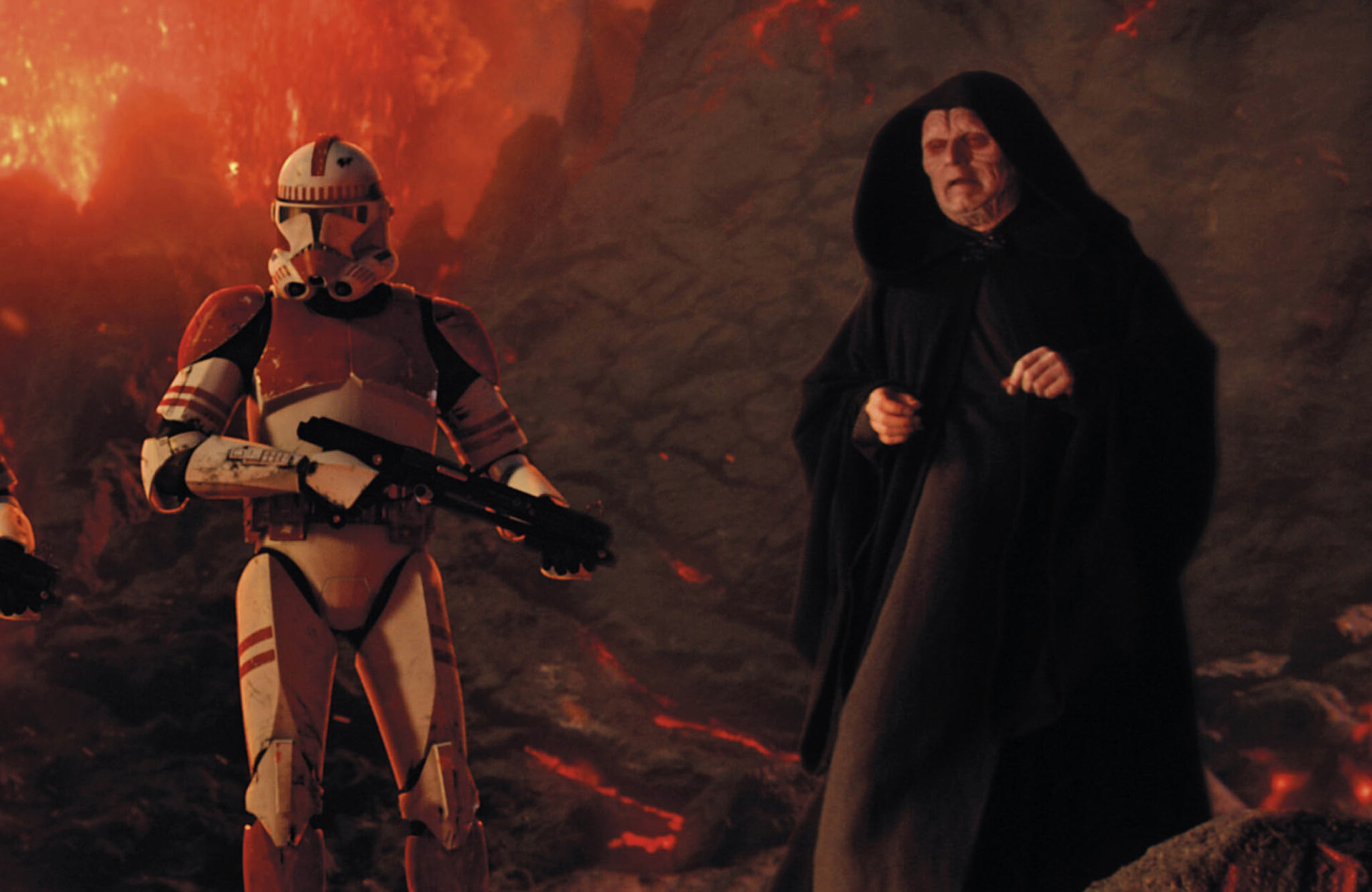
The Sith trooper, a ruthless warrior skilled in rapid movement and advanced weaponry, was designed to hunt down and eliminate all enemies of the Sith. This soldier was the result of generations of development that began in the final years of the Galactic Republic. Their predecessors, the clone troopers, were trained from their creation to be the most loyal and efficient soldiers, a process that spanned the first decade of their accelerated lives. However, Darth Sidious was troubled by the unexpected degree of independent thought displayed by these genetically engineered soldiers, despite numerous attempts to modify their genetic template. Doctor Nala Se, the Chief Medical Scientist of the Kaminoan government, determined that the Jedi were responsible for this deviation, as they encouraged the clones to act as individuals rather than as a unified group.
Following the Clone Wars, the Galactic Empire dedicated decades to removing any sense of individuality from its stormtroopers, transforming them into unwavering extensions of Emperor Palpatine's will. While not clones, stormtroopers were fiercely loyal to the Empire, yet they were considered an inferior class of soldier compared to both clone and non-clone veterans of the Clone Wars. Similar to their counterparts in the First Order, Sith troopers were born, not cloned. They were natural humans, either born on Exegol to Sith Eternal cultists or abducted by the First Order as infants; the Sith Eternal eventually recruited thousands of children. By the end of their training, they were young, in their early twenties, and stood at 1.8 meters tall. Like standard stormtroopers in the First Order, Sith troopers were denied individual names and were instead identified by serial numbers, such as ST-I4191 and ST-A1215.
To eliminate any possibility of independent thought, Sith troopers underwent flash-training and loyalty conditioning that built upon and advanced beyond the Kaminoan methods used in previous generations. Consequently, Sith troopers possessed an extreme loyalty to the Sith Eternal and their cause, becoming more obedient and droid-like than the stormtroopers of the First Order, who were trained from childhood. The most exceptional soldiers were promoted beyond the elite rank of Sith trooper, becoming a distinct class of soldier. Despite the visual similarities between First Order stormtroopers and their Sith Eternal counterparts, the key difference lay in the latter's fearless aggression, discipline, ferocity, and unwavering loyalty to the Sith. In close-quarters combat, Sith troopers operated in three-unit fire teams, trained to fight in a braced firing position covering a sixty-degree forward arc.
As children of the Sith Eternal, Sith troopers held the dark side in reverence, having been raised by cultists to embody the beliefs of the ancient Sith religion. Drawing inspiration from the Sith legacy, each Sith trooper legion adopted the name of an ancient Sith Lord in addition to their numerical designation. For example, the 3rd Legion was named after Revan, the 5th Legion after Andeddu, and the 17th Legion after Darth Tanis. The 26th Legion, the 39th Legion and the 44th Legion were named after Darth Tenebrous, Phobos and Desolous, respectively. Because Sith history was concealed from the rest of the galaxy, only Sith Eternal cultists understood the significance of these largely forgotten Sith Lords.
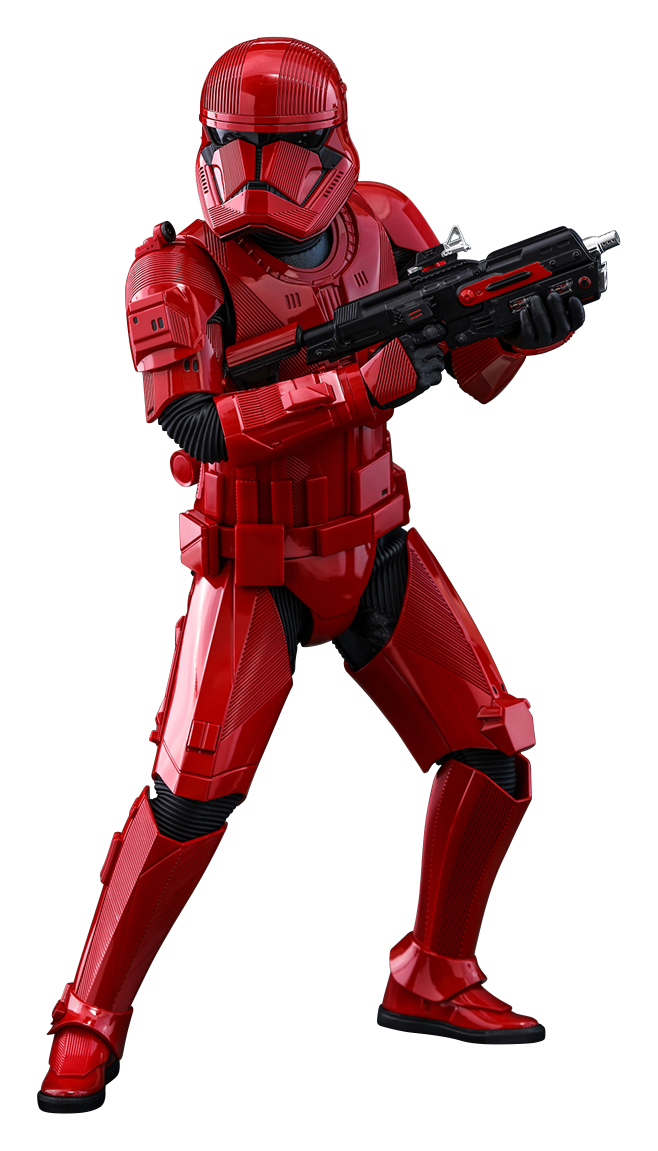
Sith trooper armor was constructed from a red gammaplast composite, layered four times to create a dense, highly impact-resistant finish. This armor was worn over a hermetically sealed black body glove. The angular planes on the face and chest plate were designed to deflect blaster bolts. The helmet's T-shaped visor was a visual reference to the Phase I and Phase II clone trooper armor. Beyond this aesthetic nod to the clone soldiers of the past, targeting sensors were integrated into the helmet to provide Sith troopers with an advantage in low-light or smoke-filled environments.
As a result, their helmets continuously transmitted battlefield data, giving Sith trooper officers a comprehensive overview of combat conditions. A commander's helmet could rapidly calculate the potential outcomes of different tactics using computer models, providing officers with recommendations based on predetermined victory conditions. This information was restricted to the command level to prevent distractions for the rank-and-file troopers during combat. Additional technological features included a wireless data antenna and an atmosphere filtration system.
The Sith troopers' right shoulder-mounted sensor telemetry pod emitted active signals that bounced and returned, providing accurate environmental data to a command center via encrypted telemetry. The right forearm gauntlet included a built-in data storage module with an access port. The armor's articulated magnatomic plates allowed for a greater range of movement, and the anisotropic bands increased the surface area for dissipating excess energy from impacts. The corrugated body glove worn beneath the gammaplast armor contained an internal atmosphere. The utility belt held power cell ammunition and a detonite explosive charge.
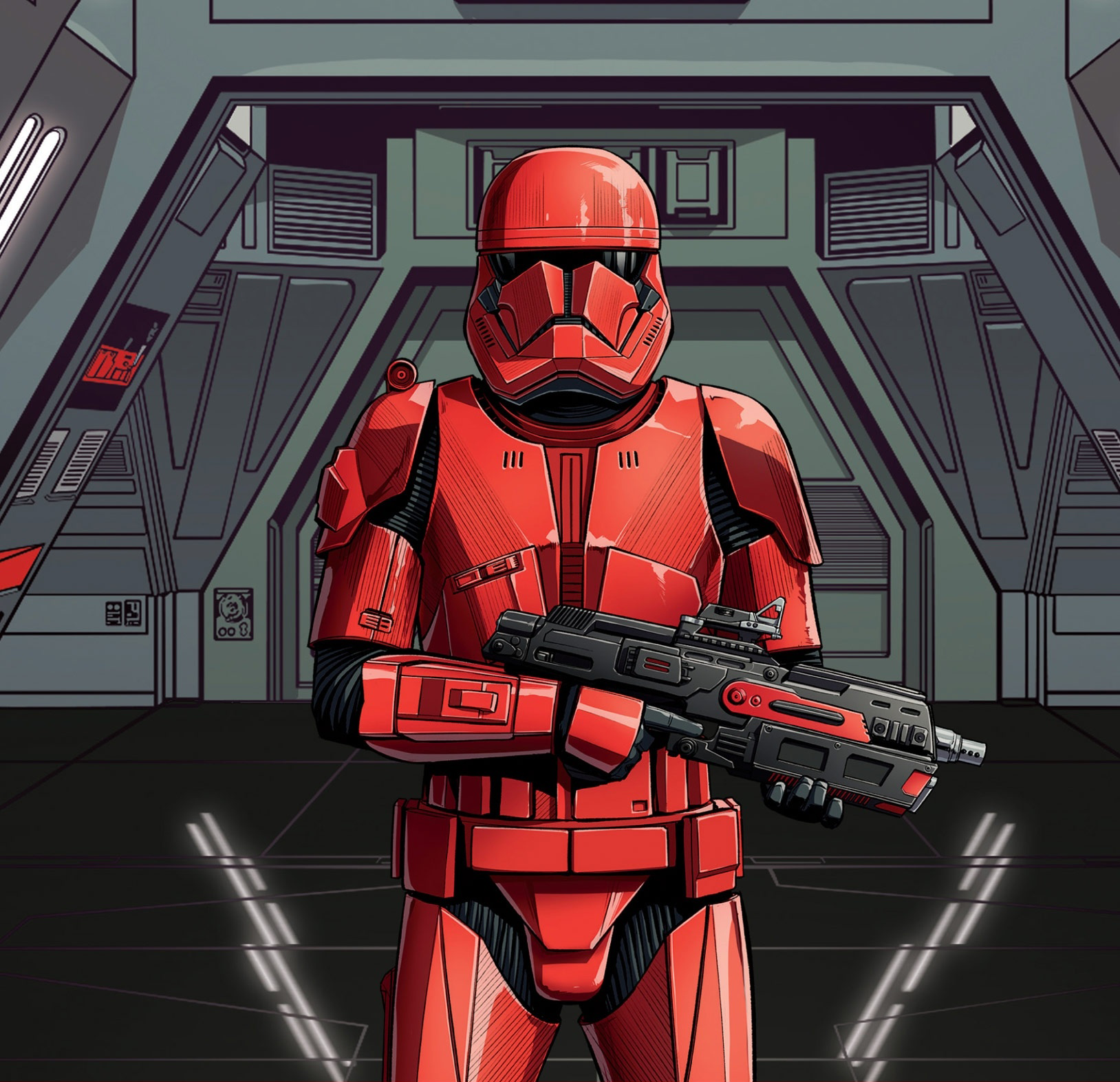
The primary weapon of the Sith troopers was the ST-W48 blaster, a heavy rifle with miniaturized technology packed into space-efficient frames. Mounted beneath the rifle's barrel were quarrel-bolt launchers, which updated and incorporated Wookiees' bowcaster technology for added explosive power. This resulted in a versatile weapon that could switch between blaster rifle and blaster carbine modes. The ST-W48 was reinforced to reduce recoil and featured an improved sight-housing and mount for greater accuracy. In carbine mode, the stock was removed for close-quarters combat.
In addition to the ST-W48, some Sith troopers carried the larger FWMB-10B repeating blaster for increased firepower. This repeating blaster, designed by Sonn-Blas Corporation, included a collapsible monopod for support, a high-resolution electroscope, and a barrel-cooling shroud. Some Sith troopers also used melee weapons, such as a vibro-blade baton held similarly to the Z6 riot control baton used by First Order riot control stormtroopers, and close combat concussion rams.
The SP-B50 blaster rifle was reserved for the Sovereign Protectors, the most elite Sith troopers. This ceremonial weapon functioned as both a blaster and a melee weapon.
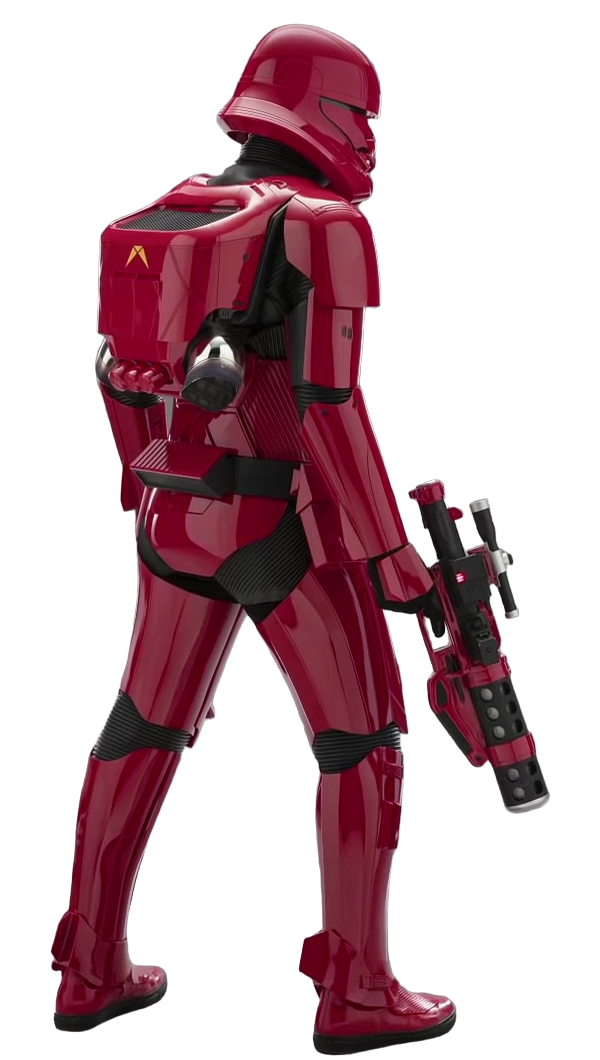
To create a flexible army capable of handling diverse combat situations, specialized troopers were trained and equipped to supplement the Sith Eternal's infantry units. Like the standard Sith infantrymen, these variants resembled their First Order counterparts, but their armor was painted in the distinctive red colors of the Sith Eternal forces.
- Sith Jetpack Trooper — Elite airborne troopers, given rigorous training and advanced equipment, including the NJP-900 integrated jetpack and the F-11ABA heavy blaster cannon. [1]
- Sith trooper Sergeant — Troopers trained for command, leading squads of ten called triads. [1]
- Sovereign Protector — The most skilled Sith troopers, elevated to the status of elite royal guards stationed in the Sith Citadel on Exegol. [1]
Sith troopers were created and developed for the 2019 film Star Wars: Episode IX The Rise of Skywalker, the final installment of the Star Wars sequel trilogy. Concept artist Glyn Dillon designed them, and Sam Williams sculpted them. Costume designer Michael Kaplan designed the Sith trooper costume. The design was inspired by the death trooper and the Elite Praetorian Guard.